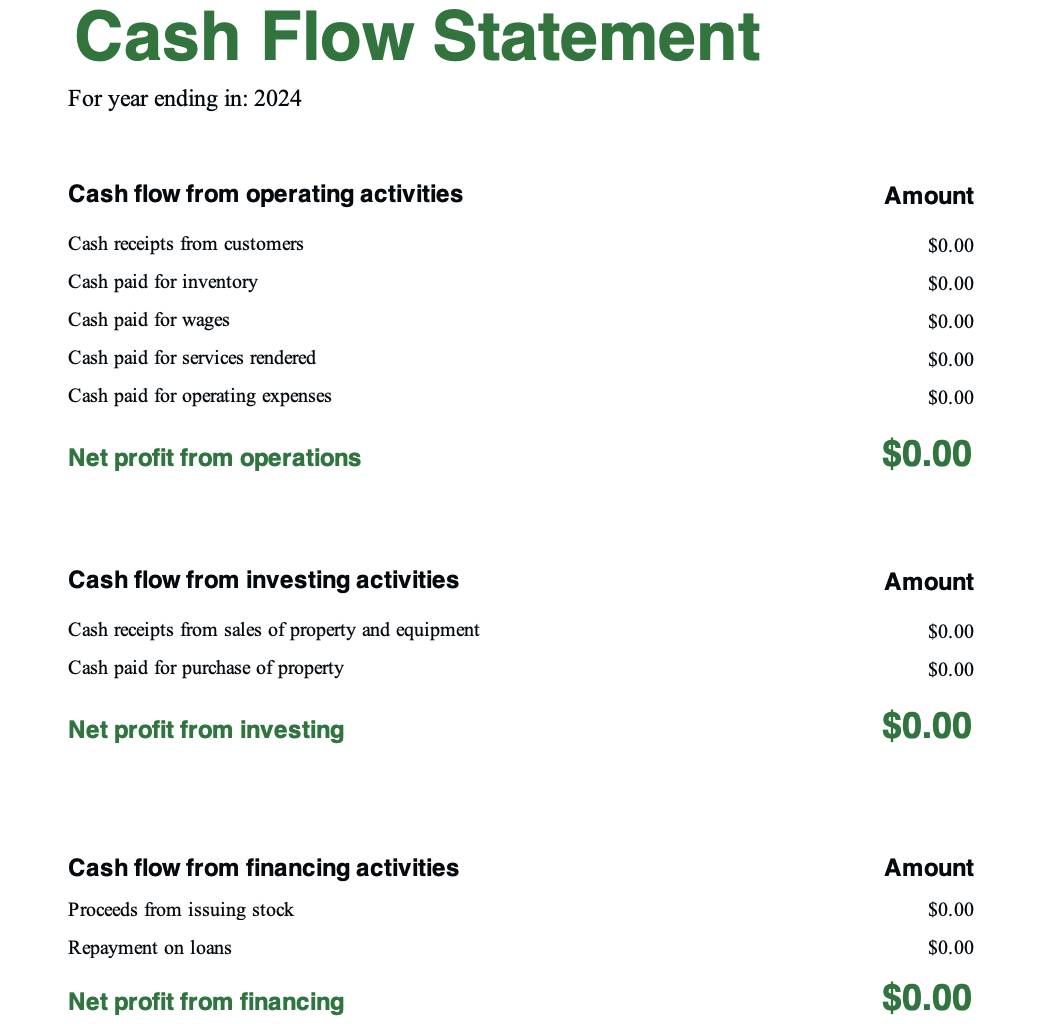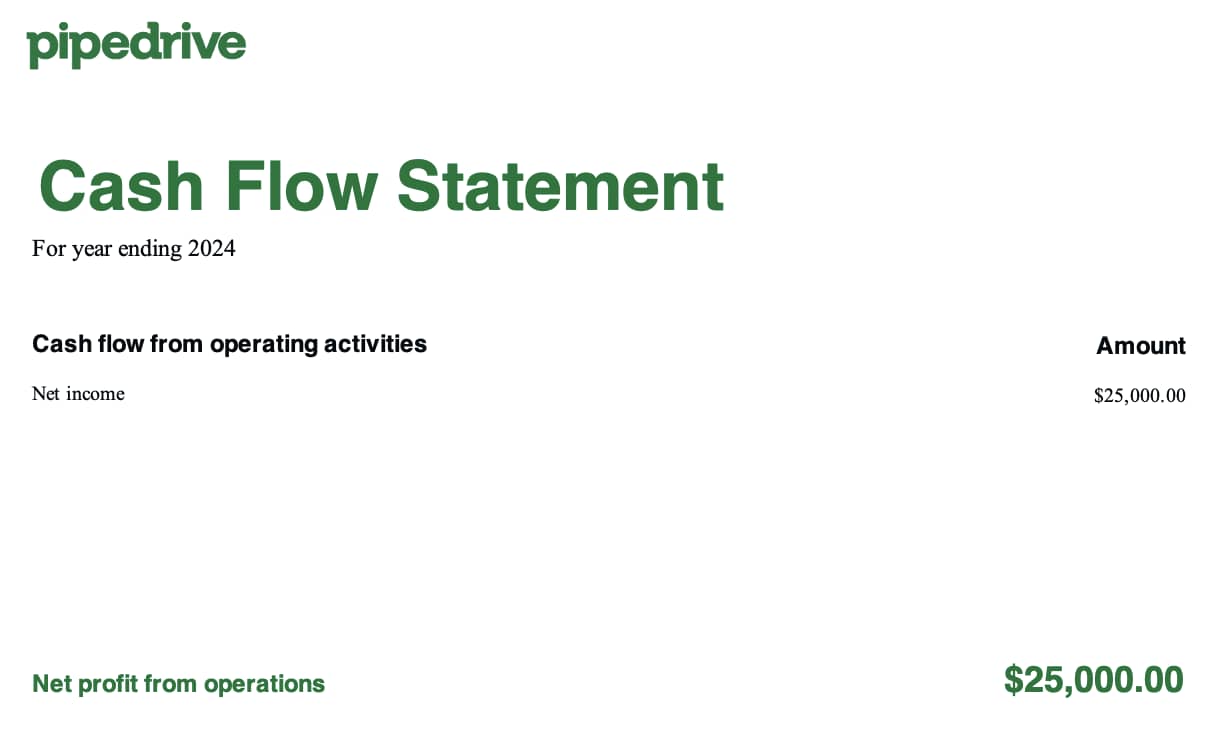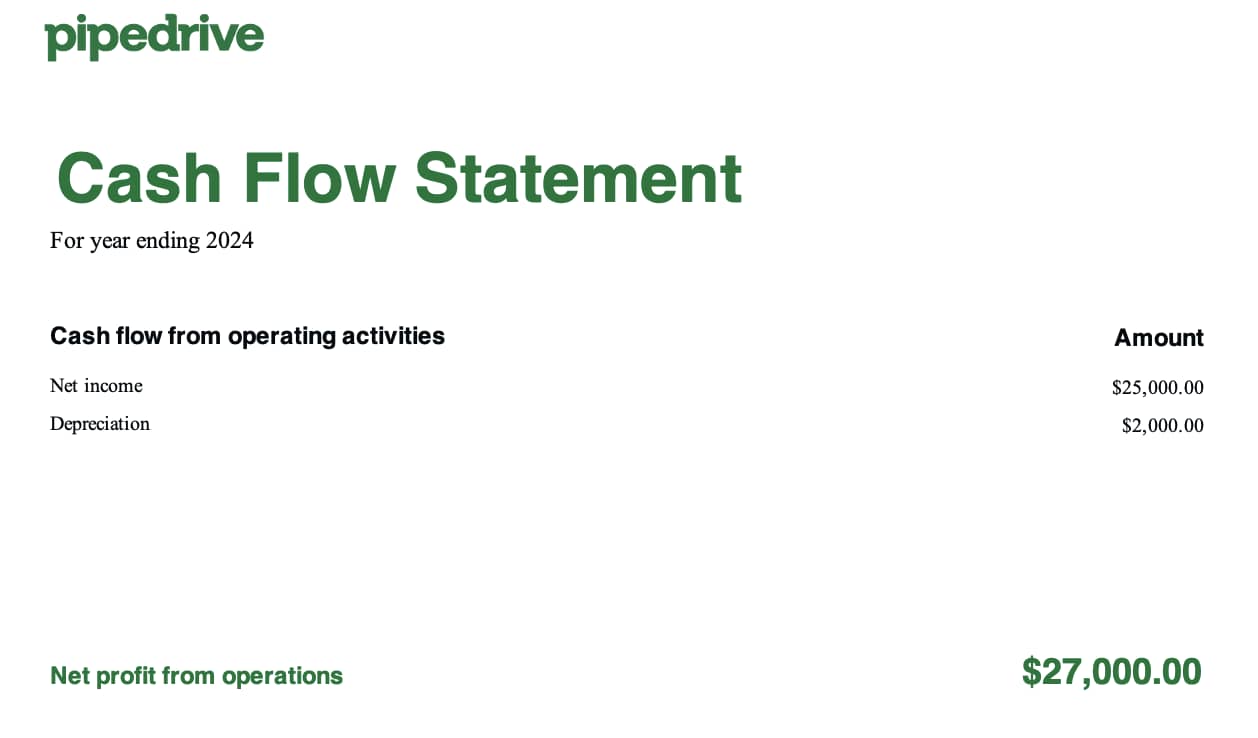Our view at Stack - Pipedrive is a robust CRM platform, offering automation, contact data collection, webhooks, AI-powered sales assistant, email communications, email marketing, and customisable sales pipeline workflows.
Cash flow statements offer a snapshot of how money moves in and out of a company, providing insight into its financial health. If you’re in business, knowing how to read and prepare cash flow statements is a crucial skill.
It can be challenging to understand cash flow statements – especially for those without a finance background.
This article clearly explains what a cash flow statement is and how it works. It also provides step-by-step guidance on preparing a statement from scratch and a template to help you get started.
What is a cash flow statement (and why is it important)?
A cash flow statement, or statement of cash flows, shows all the cash coming in and out of a company over a specific period. It’s an important financial report that helps stakeholders understand whether the business has enough money to stay afloat and grow.
The cash flow statement is important for several reasons:
-
It shows available cash. Cash flow statements help you assess your company’s cash position. You can see how much money your business has on hand to cover expenses like payroll or rent. Other statements don’t necessarily reflect actual available cash. For instance, accounts receivable might indicate income from sales. But if not all payments have come through, it won’t tell you what’s available to spend now.
-
It helps you understand business operations. A cash flow statement presents how much cash you generate from day-to-day activities. It indicates your business’s health by measuring how well you manage your cash. For instance, you can determine whether you regularly generate enough cash to pay debts and fund operating expenses.
-
It helps you evaluate your investments. Cash flow statements show how much money your company has spent on and received from investments. You can use this information to gauge your investments and see how much cash you can sustainably invest.
-
It shows how you receive and manage funding. The cash flow statement explains a company’s financing activities. It tells you how your company borrows money, issues shares and pays shareholders – giving you a good picture of your business’s financial strategy.
-
It lets you forecast cash flow accurately. Analyzing past cash flow statements helps you predict future cash flows. Accurate forecasting allows you to plan and budget without running into cash shortages.
Note: The cash flow statement is one of three key financial reports. The other two are the balance sheet (assessing the company’s current assets, liabilities and equity) and the income statement (indicating company profits and losses). These three statements give you a complete view of your company’s financial performance.
How is a cash flow statement structured?
Cash flow statements have three main sections: operating activities, investing activities and financing activities. Each section explains a different type of cash flow, giving you a complete picture of where the cash comes from and how it’s used.
Cash flow from operating activities
The operating section shows how much cash the business generates from and spends on core business operations. It includes:
-
Net income
-
Cash from sales
-
Payments to suppliers for goods and services
-
Cash paid for salaries and wages
-
Operational expenses like utilities and rent
-
Adjustments for non-cash expenses (e.g., depreciation of equipment)
Operating cash flow indicates your company’s cash-generating efficiency. It helps you assess whether you have enough cash to fund day-to-day operations without borrowing or selling assets.
Cash flow from investing activities
This section of the cash flow statement displays cash transactions related to long-term assets (assets you plan to hold for more than a year – like buildings, machinery and equipment). It includes:
-
Cash spent buying land or equipment
-
Cash received from selling assets or securities
-
Cash spent on or received from investments in other companies
Analyze this section to calculate whether your business is investing smartly. Generally, small businesses and startups have negative cash flow from investing activities since they focus on business growth. Larger companies may have more diverse investments with a positive cash flow.
Cash flow from financing activities
The third section indicates cash flow related to how your company raises funds. It includes:
-
Cash received from new debt (e.g., loans)
-
Cash spent repaying debt
-
Money received from selling shares
-
Cash paid out as dividends to shareholders
This section gives you insights into the strength of your company. Investors will look at this section to determine if your business has a good financial footing.
Recommended reading

Everything you need to know about small business management
Cash flow statement example
Below is an example of a hypothetical company’s cash flow statement. It comprises three sections – one for each type of cash flow.

Each section lists positive and negative cash flows, illustrating how each category contributes to the company’s financial health.
The above cash flow statement example includes the following key elements:
A positive operating cash flow. In the first section, you can see that operating business activities have a positive net cash flow. The net income (cash received from customers) is higher than the outflows, suggesting the business makes enough sales to sustain itself.
A positive investing activity cash flow. Investing activities have a positive cash flow of $2,000 from the sale of assets. A positive cash flow demonstrates that the company is selling assets rather than investing in new ones. It doesn’t indicate immediate financial health problems, but it could be an issue if the company needs to grow.
A negative financing activities cash flow. Cash paid for dividends and debt outweighs the income from issuing stock. The cash flow is negative in the financing activities section, which isn’t necessarily bad. It might signal that the company invests in planned future growth and profitability.
Overall, the company in the example appears to be operationally healthy and managing its debt well. With that said, stakeholders might look into its long-term growth strategy with potential concerns about investment and asset management.
Recommended reading

14 business management software solutions that increase efficiency
How to prepare a cash flow statement
You can prepare your own cash flow statement using a spreadsheet or download our cash flow statement template to get started now. Here’s a step-by-step guide on how to prepare your statement.
1. Determine the reporting period
Most companies prepare a cash flow statement quarterly, monthly or annually. Each accounting period provides different insights, so choose the one that best reflects your company’s performance.
Download Your Guide to Sales Performance Measurement
The must-read guide for any sales manager trying to track, forecast and minimize risk. Learn how to scale sales with data-backed decisions.
Here are some tips for selecting the right reporting period for your business:
-
Align your cash flow statement with other financial statements. If your company prepares its income statement and balance sheet each quarter, your cash flow statement should be quarterly, too.
-
Check regulatory guidelines for mandatory reporting periods. Some jurisdictions specify when you have to provide financial statements. Check your local accounting standards and regulatory bodies for guidelines.
-
Consider your business’s seasonality. Choose a period that captures seasonal changes in cash flow for more meaningful insights. For example, a retail business might benefit from quarterly reports that reflect seasonal sales cycles.
2. Gather financial records
Collect your records for your reporting period. You’ll need your income statement, balance sheet and any documentation covering transactions during that time.
3. Calculate cash flow from operating activities
You can calculate cash flow from operating activities using either the direct or indirect method. Here’s how the two methods compare.
Indirect method: starts with your net income and works backward, converting it into cash flow by adding and subtracting non-cash items (like depreciation). Most companies use this method because it’s quicker and easier.
Direct method: involves adding up your transactions to calculate net cash flow. It’s simple but may be time-consuming to collect and organize everything.
Let’s take a closer look at how to calculate operating cash flow using each method.
How to calculate operating cash flow with the indirect method
Operating activities count toward your income and expenditure even when there’s no money transfer. Your cash flow remains the same until cash actually changes hands.
The indirect method involves adding or subtracting both cash and non-cash activities to or from your net income as follows:
1. Start by recording the net income from your income statement.
Say your income statement shows a net income of $25,000. The first line of your cash flow statement would look like this:

2. Add non-cash expenses like depreciation and amortization. In an income statement, you deduct these expenses to calculate net income. In a cash flow statement, you add them back in because they don’t involve spending cash.
For instance, say your only non-cash expense is depreciation of $2,000. Since depreciation doesn’t affect your cash holdings, add the $2,000 to your net income. Here’s what that would look like:

3. Adjust for balance sheet items like accounts payable and inventory that don’t reflect cash transactions.
If you’re using accrual accounting, you record transactions on your balance sheet when they occur rather than when you receive payment for them. Accounts payable, for instance, may show a profit immediately even though you won’t receive the cash until later.
You’ll deduct an increase in accounts receivable from the net income to reflect that.
Similarly, deduct any inventory increase for the period you’re reporting. An increase means you spent cash on stock, but this spending isn’t reflected in your net sales income. You need to include it as a separate line item.
Here’s how to adjust your net income for each of the operating activities on your balance sheet:
|
Operating activity |
Adjustment | Reasoning |
| Depreciation expenses | Add to net income | Depreciation expenses don’t affect cash flow |
| Decrease in accounts receivable | Add to net income | The company collected cash from previous credit sales |
| Increase in accounts receivable | Subtract from net income | The company made more sales on credit, collecting less cash |
| Decrease in accounts payable | Subtract from net income | The company used cash to pay some of what it owes |
| Increase in accounts payable | Add to net income | The company delayed payments to conserve cash |
| Decrease in prepaid expenses | Add to net income | The company spent cash during a different period, which doesn’t affect the current cash flow |
| Increase in prepaid expenses | Subtract from net income | The company spent for future goods or services |
| Decrease in inventory | Add to net income | The company sold inventory, converting it back to cash |
| Increase in inventory | Subtract from net income | The company spent money on stock |
| Decrease in deferred taxes | Subtract from net income | The company paid cash for deferred tax liabilities |
| Increase in deferred taxes | Add to net income | The company deferred income taxes, increasing cash flow |
Returning to our previous example, say your balance sheet shows that accounts receivable has increased by $5,000 and inventory by $2,000. Subtract these from your net income to get your operating cash flow.
With all the operating activities accounted for, the net profit from operations comes to $20,000.
How to calculate operating cash flow with the direct method
-
Add up all cash receipts from clients and customers to find your starting cash balance.
-
Add up all cash payments to suppliers and employees to see how much you’ve spent on operational expenses.
-
Subtract the expenses from the total sales receipts to find the net cash flow from operating activities.
Let’s look at an example. Say your cash transaction records for the reporting period and all your cash receipts add up to $100,000.
You analyze your company’s expenses and find $2,500 in supplies, $4,000 for services rendered, $40,000 in wages and $5,000 for rent and utilities.
Add these to your cash flow statement and calculate your cash flow from operating activities at $48,500.
Both the indirect and direct methods accurately calculate the amount of cash your company generates from core business operations. Use whichever one best fits your company’s accounting practices and reporting needs.
4. Calculate cash flow from investing activities
To complete the second section of your cash flow statement, you need to calculate investment gains and expenditures. Investment cash flow is simple: buying assets reduces cash flow while selling assets increases it.
To get started with this calculation, check your income statement and balance sheet for investment activities. For instance, you might look for capital expenditures (CapEx) – cash payments you use to buy long-term assets like property and equipment.
When you have a complete list of activities, sum up the cash inflows and outflows to calculate the net cash flow from investing activities.
Example: Your company bought new equipment and a warehouse for $140,000 and sold a vehicle for $30,000. Your net cash flow from investing activities is –$140,000 + $30,000, meaning your net profit from investing is –$110,000.
5. Calculate cash flow from financing activities
This section documents how your company raises capital and pays it back. There are three steps to calculate cash flow from financing activities.
1. Add up the ways you’ve generated cash through financing activities. These might include:
2. Add up your outflows of cash, which can comprise:
-
Loan repayments or redeeming bonds
-
Buying back shares of the company’s own stock
-
Paying dividends to shareholders
3. Subtract the total cash outflows from the total cash inflows to get the net cash flow from financing activities.
Say your company issued $50,000 worth of stock but paid $20,000 to service loans and dividends. You have a net cash flow from financing activities of $30,000.
6. Calculate the net cash flow for the period
The final step to creating your cash flow statement is determining the total cash flow for your reporting period. You do this by combining cash flows from each of the three sections.
The end value of -$30,000 indicates a loss of cash during the year, meaning the company spent more cash than it brought in.
You can evaluate this total cash flow against your goals and expected outcomes to determine whether your company is on a sustainable path to reaching its business objectives.
Cash flow statement FAQs
Final thoughts
Mastering cash flow statements helps business owners make informed decisions and maintain good financial health. By tracking exactly where the money is going, your company can predict future cash needs and optimize operational strategies.
Are you ready to streamline your financial management?
Sign up for a 14-day free trial to see how Pipedrive can transform your cash flow insights into actionable business strategies.
If Pipedrive is of interest and you'd like more information, please do make contact or take a look in more detail here.
Credit: Original article published here.
